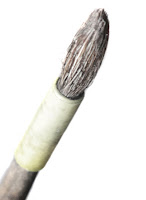"(...) the criterion
of common sense was never applicable to the history of the human
race"
The Futurological Congress
S. LEM
"Kryterium zdrowego rozsądku nie jest do historii ludzkiej stosowalne"
Kongres Futurologiczny
S. LEM
Necessity is the mother of invention. I've
been working under great pressure of time lately. Well, it's rather difficult
to think properly at 2 a.m so I had to figure out how to draw... without thinking.
Even though it's hard to believe, I did
it! Below you'll see the method of painting attractive and yet extremely easy
tree.
Potrzeba jest matką
wynalazków. Ponieważ ostatnio pracowałam pod sporą presją czasu, a o 2 w nocy
dość ciężko mi się myśli, musiałam opracować sposób na rysowanie... bez myślenia.
Choć trudno w to uwierzyć, udało mi się! Poniżej zobaczycie sposób na efektowne
i zarazem ekstremalnie łatwe drzewo.
Tools: paper, water, waterproof pen, watercolors, salt (nothing special actually) and:
Przybory: papier, woda, wodoodporny cienkopis, akwarele, sól (właściwie nic nadzwyczajnego) oraz:
masking fluid
fluid maskujący
a
cheap, worn-out brush with synthetic, hard bristles
tani, zużyty pędzel z syntetycznym, twardym włosiem
a watercolor brush with soft, natural bristles
pędzel do akwareli z miekkim, naturalnym włosiem
an old,
round shaving brush
stary, okrągły pędzel do golenia
1. A quick, rough sketch. A very low level of thinking is required - the shape should more or less resemble a tree. Just remember that branches should cross each other to show that the tree is 3-dimensional.
1. Szybki szkic. Wymagany jest bardzo niewielki stopień myślenia - ot, kształt powinien mniej więcej przypominać drzewo. Należy pamiętać tylko o jednej zasadzie - gałęzie powinny się ze sobą przecinać, żeby symulować przestrzenność drzewa.
2. Masking fluid on the trunk. We have to
choose the direction of the light. If we don't want to think about it we can
flip a coin. In this case the light fall from the left. We use a cheap brush with synthetic bristles to put the fluid on illuminated
areas. The farther from illuminated areas the less fluid we put. Generally we
don't have to think much then. The bark pattern comes by itself.
2. Fluid
maskujący na pniu drzewa. Trzeba zdecydować, z której strony pada światło.
Można rzucić monetą, jeśli nie chce się nam nad tym zastanawiać. W tym
przypadku światło będzie z lewej. Na stronę, która ma być oświetlona należy
nałożyć fluid za pomocą możliwie sztywnego i "rozczłapanego" pędzla.
Im dalej od oświetlonego centrum, tym delikatniej przyciskamy pędzel. W
zasadzie nie trzeba przy tym myśleć, faktura kory wychodzi sama.
3. Masking
fluid on leaves. We put the fluid by quickly pressing our old
brush to the paper (without pulling it). We should place the fluid in the tree
crown area but it's hard to call it "thinking" actually.
3. Fluid
maskujący na koronie drzewa. Nakładamy punktowo przyciskając rozczłapany pędzel
(bez przesuwania po kartce). Powinniśmy nakładać fluid w obrębie korony drzewa,
niemniej trudno tu mówić o myśleniu.
4. Now we have to wait for 15-20 minutes
because fluid needs to dry up. You can stare at your own feet then (hopefully
your feet look better).
4. Trzeba
odczekać 15-20 minut, aż fluid wyschnie. Można w tym czasie bezmyślnie
wpatrywać się w swoje stopy (wasze stopy prawdopodobnie będą wyglądały lepiej).
5. Painting the trunk - I mixed delicately
(even carelessly) violet, sepia, red and burnt sienna (so they were not combined into a single color). We
paint over whole trunk without thinking about the fluid. We just have to bear in mind that illuminated
areas should be painted with more diluted paint than shadowed areas. Before the
paint dries up we can put grains of salt on it. Required level of thinking - very low.
6. Painting the crown - We put the paint with
an old, round shaving brush and then we put some salt on it. Required level of
thinking - even lower than in previous step.
6.
Malowanie korony - Przy użyciu starego pędzla do golenia nakładamy plamy farby
i solimy. Wymagane myślenie - jeszcze mniejsze niż w
punkcie poprzednim.
7.
Repetition of step 4. allows the paint to dry up. This time we turn off most of
concious body functions for about half an hour.
7.
Powtarzamy pkt 4., aby pozwolić wyschnąć farbie. Tym razem wyłączamy większość
świadomych funkcji organizmu na ok. 30 minut.
8. We take the fluid and grains of salt off thoughtlessly.
8.
Bezmyślnie zdejmujemy fluid i ziarenka soli.
9. Finally we have to turn on thinking a bit,
though I call it intuition. We grab the pen and highlight the bark pattern, created
accidently with masking fluid and salt.
9. Na
koniec trzeba włączyć nieco myślenia,
choć ja nazywam to intuicją. Łapiemy
piórko i podkreślamy nim rysunek kory, otrzymany dość przypadkowo za pomocą
fluidu maskującego i soli.
10. It's finished! Painting rocks in the next
post.
















Szkoda tylko, że pociągu to nie przejdzie, ale na to już mam wypracowane bezmyślne szkicowanie (: Muszę wziąć i wypróbować maskujący fluid w końcu, zbieram się do tego tak jak do kupowania białego tuszu ostatnio.
ReplyDeleteTeż się ociągałam z fluidem maskującym, ale im dłużej go używam, tym ciekawsze zastosowania dla niego znajduję. A o białym tuszu nawet nie słyszałam... ale wyszukam co to takiego :)
Delete